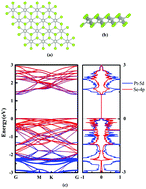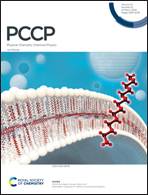Steady semiconducting properties of monolayer PtSe2 with non-metal atom and transition metal atom doping
Abstract
Based on density functional theory, the electronic structure and magnetic properties of monolayer PtSe2 doped with different atoms were studied. The Pt and Se atoms are replaced by a transition metal atom (Mn) and a non-metal atom X (X = N, P, As), respectively. The pristine monolayer PtSe2 is a semiconductor with an indirect band gap of 1.352 eV. For one non-metal atom doping, the doped system exhibits indirect band gap magnetic semiconducting properties and the magnetic moment is less than 1 μB and mainly comes from the hybridization of Pt-5d and X-p orbitals. The N-Doped system still retains the magnetic semiconducting properties under strain (from −10% to 13%) and the band gap varies from 0.059 eV to 1.308 eV. For two X doped systems, three different configurations are considered. The doped systems retain the indirect band gap semiconducting properties except for the third nearest neighbor N-doped system (direct band gap). But, for all N-doped and the second nearest neighbor P-doped systems, the magnetic moment increases to more than double. Meanwhile, all X-doped monolayer PtSe2 systems exhibit p-type semiconducting characteristics. For (Mn, X) co-doped systems, the magnetic moments are mainly localized in the Mn 3d orbital and there is strong p–d hybridization between Mn atoms and X atoms. The (Mn, N/P) co-doped system still exhibits magnetic semiconducting properties. These results are important for designing semiconductor devices and electronic spin devices based on monolayer PtSe2.



 Please wait while we load your content...
Please wait while we load your content...